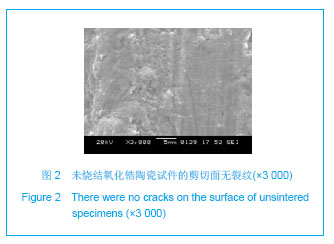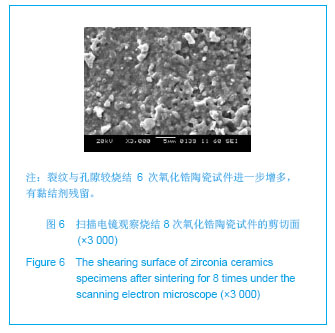| [1]张金明,陈利民,高平.氧化锆陶瓷与三种树脂粘接剂粘接剪切强度比较[J].现代口腔医学杂志,2011,25(1):41.[2]张玮,姚畅旺,韩栋伟.表面处理对Cercon氧化锆陶瓷黏结强度的影响[J].实用口腔医学杂志,2007,23(2):272-275.[3]盛相军,金志浩,王永兰.氧化锆用于牙修复的研究进展[J].硅酸盐通报,2003,22(5): 74.[4]严少文,刘丽.减少金属修复体在磁共振成像中伪影的研究进展[J].国际口腔医学杂志,2008,35(6):712-714.[5]高戈,夏海斌,李小倩,等.自由成形制备氧化锆全瓷牙种植体的初步研究[J].生物医学工程与临床,2011,15(6):521-525.[6]张慧敏,杨建军,林映辉,等.烧结温度对氧化锆基台材料机械性能的影响[J].中国组织工程研究与临床康复,2011,15(8): 1421-1424.[7]Blatz MB,Chiche G,Holst S,et al.Influence of surface treatment and simulatedaging on bond strengths of luting agents to zirconia. Quintessence Int.2007; 38(9):745-753.[8]Kato H,Matsumura H,Atauta M.Effect of etching and sandblasting on bond strength to sintered porcelain of unfilled resin.J Oral Rehabil.2000;27(2): 103-110.[9]Shen C,Oh WS,Williams JR.Effect of post-silanization drying on the bond strength of composite to ceramic.J Prosthet Dent.2004;91(5): 453-458.[10]Matinlinna JP,Lassila LV,Vallittu PK.The effect of a novel silane blend system on resin bond strength to silica-coated Ti substrate.J Dent.2006;34(7):436-443.[11]Yoshida K,Tsuo Y,Atsuta M.Bonding of dual-cured resin cement to zirconia ceramic using phosphate acid ester monomer and zirconate coupler.J Biomed Mater Res B Appl Biomater.2006;77(1):28-33.[12]Thompson JY,Stoner BR,Piascik JR,et al.Adhesion/ cementation to zirconia and other non-silicate ceramics: where are we now.Dent Mater.2011;27(1): 71-82.[13]Kitayama S,Nikaido T,Takahashi R,et al.Effect of primer treatment on bonding of resin cements to zirconia ceramic. Dent Mater.2010;26(5): 426-432.[14]Dias de Souza GM,Thompson VP,Braga RR.Effect of metal primers on microtensile bond strength between zirconia and resin cements.J Prosthet Dent. 2011;105(5): 296-303.[15]Kern M,Wegner SM.Bonding to zirconia ceramic: adhesion methods and their durability.Dent Mater.1998;14(1): 64-71.[16]Blatz MB,Sadan A,Martin J,et al.In vitro evaluation of shear bond strengths of resin to densely-sintered high-purity zirconium-oxide ceramic after long-term storage and thermal cycling.J Prosthet Dent.2004;91(4): 356-362.[17]温宁,伊元夫,邵龙泉,等.表面处理方法对牙科氧化锆陶瓷表面相结构及微观结构影响[J].稀有金属材料与工程,2009,12(38): 823-825.[18]Hochman N,Zalkind M.New all-ceramic indirect post-and-core system.J Proshet Dent.1999;81(5): 625-629.[19]李伟,蒋丽,廖运茂.牙科氧化锆全瓷材料[J].中国实用口腔科杂志,2010,8(8):455.[20]闫海鑫,哈斯达来,吴 琳,等.喷砂处理对氧化锆陶瓷基底与饰面瓷结合强度的影响[J].口腔医学,2011,31(2):96-98.[21]Sameshima GT,Sinclair PM.Predicting and preventing root resorp-tion: Part II.Treatment factors.Am J Orthod Dentofacial Orthop.2001;119(5): 511-515.[22]苏晓晖,龚晴昕,黎松龄,等. 烧结温度对氧化锆/饰面瓷抗热冲击耐力的影响[J].临床口腔医学杂志,2013,29(1):28-30.[23]金志浩,高积强,乔冠军.工程陶瓷材料[M].西安:西安交通大学出版社,2000:196-198.[24]黄慧,魏 斌,张富强,等.两次烧结工艺对氧化锆陶瓷性能的影响[J].华西口腔医学杂志,2008,23(2):175-178.[25]邓斌,伊元夫,温宁,等.多次烧结对氧化锆-饰面瓷结合强度的影响[J].硅酸盐通报,2009,28(s1):58-61. [26]Isgrò G,Wang H,Kleverlaan CJ,et al.The effects of thermal mismatch and fabrication procedures on the deflection of layered all-ceramicdiscs.Dent Mater.2005;21(7):649-655.[27]Guazzato M,Quach L,Albakry M,et al.Influence of surface and heat treatments on the flexural strength of Y-TZP dental ceramic.J Dent.2005;33(1): 9.[28]刘纯波,于连生,蒋显亮.纳米 ZrO2-8%Y2O3粉末的相转变及晶粒生长动力学[J]. 中国有色金属学报,2011,21(12): 320-3128.[29]李婷,章浙锋,周谧,等.喷砂表面处理技术在口腔全瓷修复中的应用[J].国际口腔医学杂志,2012,37(2):206-208.[30]Taskonak B, Yan J, Mecholsky JJ Jr, et al.Fractographic analyses of zirconia-based fixed partial dentures.Den Mater. 2008;24(8): 1077.[31]张磊,胡书海,任翔,等.树脂黏结剂及氧化锆陶瓷剪切黏结强度与不同表面处理方式的关系[J].中国组织工程研究与临床康复, 2010,14(42):7879-7872.[32]谭晓蕾,张少锋,郭航,等.硅烷偶联剂及自酸蚀粘结剂对VitaMark Ⅱ与牙本质粘结强度的影响[J].口腔颌面修复学杂志,2009,10(2):109-112.[33]Uo M,Sjgren G,Sundh A,et al.Cytotoxicity and bonding propertyof dental ceramics. Dent Mater.2003; 19(6): 487-492.[34]Monticelli F,Ferrari M,Toledano M.Cement system and surface treatment selection for fiber post luting.Med Oral Patol Oral Cir Bucal. 2008;13(3):E214-221.[35]陈震,尹保迪,王思钱,等.不同粘固前处理方法对氧化锆陶瓷粘结性能的影响[J].口腔医学,2011,31(3):159-161.[36]Oonsombat C,Bishara SE,Ajlouni R. The effect of blood contam-ination on the shear bond strength of orthodontic brackets with the use of a new self- etch primer.Am J Orthod Dentofacial Orthop.2003;123(5): 547-550.[37]Mao J,Qi J.Effect of saliva contamination on shear bond strength of orthodontic brackets when using a self-etch primer.J Hua-zhong Univ Sci Technolog Med Sci.2005; 25(1):111-112.[38]张玉华,梁甲兴,林立,等.唾液对托槽-弓丝-结扎丝结构摩擦力的影响[J].福建医科大学学报,2007,41(2): 147-149.[39]王瑜,谢海峰,章非敏.牙科氧化锆陶瓷表面不同浓度硅溶胶改性对其粘接强度的影响[J].实用口腔医学杂志,2008,24(4): 518-521. |





